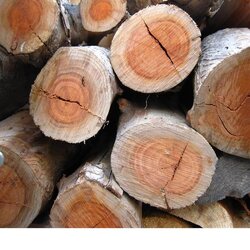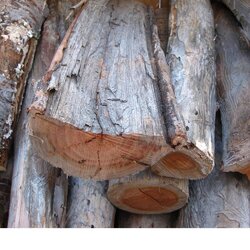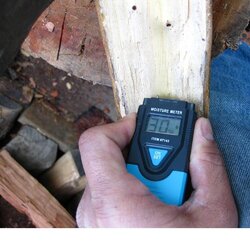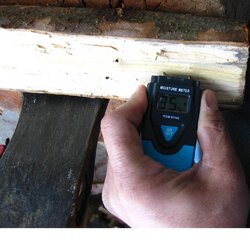Ok I don't know what to make of this. I got about 1/2 cord of dry eucalyptus free from a craigs list ad. When I split it it was definitely dry, the moisture meter read anywhere from 13-18*. So I only split some of the larger rounds and left the smaller ones intact. (they were all from the same recently felled dead tree). Enough background now for the problem. I loaded my stove with some pine and a few splits of euc. As the fire grew I heard a sound that I had not heard all winter, my stove sprung a leak :bug: that puppy was hissing up a storm. When I looked in the window I noticed that the euc had some moisture escaping from the outer edges of the ends. I thought perhaps it wasn't as dry as I thought or maybe I threw in a wet piece by mistake. I then realized that I had just split and checked the moisture on those splits they registered as dry! I don't get it. I have had several fires and every time I use the euc same issue. It is DRY I know it is. It looks, feels, sounds and registers as dry. Not only that, it catches fire quickly and coals up very well. I just don't know, perhaps its sap? I touched it and it seems like water not sticky so not sap. Has anyone had this happen to them when burning eucalyptus? Perhaps this is normal for euc. I don't know all I have burned so far is pine and redwood(I think).
MOISTURE METER SAYS DRY BUT WOOD IS HISSING AND LEAKING
- Thread starter THEMAN
- Start date
-
Active since 1995, Hearth.com is THE place on the internet for free information and advice about wood stoves, pellet stoves and other energy saving equipment.
We strive to provide opinions, articles, discussions and history related to Hearth Products and in a more general sense, energy issues.
We promote the EFFICIENT, RESPONSIBLE, CLEAN and SAFE use of all fuels, whether renewable or fossil.
You are using an out of date browser. It may not display this or other websites correctly.
You should upgrade or use an alternative browser.
You should upgrade or use an alternative browser.
- Status
- Not open for further replies.
LLigetfa
Minister of Fire
Sounds like the moisture is near the surface, under the bark. Also, it could be that your moisture meter needs to be recalibrated for that species. Some meters come with a fudge factor table for different species. They can also read different with the grain versus across the grain.
dave11
Minister of Fire
I've had a slight hiss too, with wood reading reliably 17-20%, but 17% isn't zero. There's always going to be some moisture in the wood unless it's stored in a zero percent humidity environment. How dry it needs to be before you don't hear the hiss any longer probably varies based upon the species and the size of the pieces. I've also noticed that lots of smaller twigs that I use for kindling will hiss, even though they've been sitting in a box inside for more than 6 months.
Makes me wonder if something besides water boiling off can cause hissing.
I've been ignoring the hiss, if I get hot temps and great secondary burn.
Makes me wonder if something besides water boiling off can cause hissing.
I've been ignoring the hiss, if I get hot temps and great secondary burn.
nlittle
New Member
The mistake I made when first using my meter was going across the grain instead of with it when poking the split. Reads much different this way!
Chettt
Feeling the Heat
Eucalyptus trees that were planted in arid countries have had to be destroyed because they consume so much water to live. I've burnt some in a fireplace in South Africa and it hissed like a black mamba.
Bigg_Redd
Minister of Fire
THEMAN said:MOISTURE METER SAYS DRY BUT WOOD IS HISSING AND LEAKING
So sh_tcan the moisture meter
savageactor7
Minister of Fire
Leaking and hissing are signs of unseasoned wood. Why not test your MM on some fresh cut wood and see what it says?
Tony H
Minister of Fire
you could also check the meter by testing the MC of a 2x4 it should read less than 5 on the meter.
Nonprophet
Minister of Fire
LLigetfa said:Sounds like the moisture is near the surface, under the bark. Also, it could be that your moisture meter needs to be recalibrated for that species. Some meters come with a fudge factor table for different species. They can also read different with the grain versus across the grain.
For most species in the US the variation between species is only 1% +/- That being said the TEMPERATURE of the split can vary the results by as much as 5%. I'd recommend what others have said and test your MM against a scrap of KD 2x4 to see what you get, though now that I think about it it's possible that your meter is reading much lower than it should be--i.e. it says 11-18% when the split really 30% or so, but worth a check anyway on the 2x4.
Lastly, you did split a split open and check the moisture level INSIDE the split, right?
NP
Nonprophet said:LLigetfa said:Sounds like the moisture is near the surface, under the bark. Also, it could be that your moisture meter needs to be recalibrated for that species. Some meters come with a fudge factor table for different species. They can also read different with the grain versus across the grain.
For most species in the US the variation between species is only 1% +/- That being said the TEMPERATURE of the split can vary the results by as much as 5%. I'd recommend what others have said and test your MM against a scrap of KD 2x4 to see what you get, though now that I think about it it's possible that your meter is reading much lower than it should be--i.e. it says 11-18% when the split really 30% or so, but worth a check anyway on the 2x4.
Lastly, you did split a split open and check the moisture level INSIDE the split, right?
NP
Yes I split the wood open and checked both with and across the grain. The 2x4 in the garage read 08% on the meter, I also split a round of redwood that has been seasond for a couple of years and it read 13% this wood does not hiss nor leak when burnt. I guess as some of the other posters said perhaps its residual moisture.
burntime
New Member
Your moisture meter is lying to you. Believe nothing it tells you. Before you know it someone else will be drinking your beer! :lol:
burntime said:Your moisture meter is lying to you. Believe nothing it tells you. Before you know it someone else will be drinking your beer! :lol:
They can have the beer. They better not touch the rum and cigars or there will be hell to pay.
Martin Strand III
New Member
Putting your hopes in modern electronic gadgets and/or others words sometimes sets you up for disappointment or worse.
When you buy wood, don't know its history, are unfamiliar with the species, and have only the dubious words of the seller "It's seasoned.", your purchased wood is usually dry when:
1. The bark tends to fall off the split
2. Knocking 2 similar split pieces together "clink" rather than "clunk"
3. You see multiple radial cracks on the cut end
4. The color of the split has greyed or browned (weathered look)
Aye,
Marty
Grandma used to say, "Sometimes, take what others say with a grain of salt."
When you buy wood, don't know its history, are unfamiliar with the species, and have only the dubious words of the seller "It's seasoned.", your purchased wood is usually dry when:
1. The bark tends to fall off the split
2. Knocking 2 similar split pieces together "clink" rather than "clunk"
3. You see multiple radial cracks on the cut end
4. The color of the split has greyed or browned (weathered look)
Aye,
Marty
Grandma used to say, "Sometimes, take what others say with a grain of salt."
northwinds
Minister of Fire
Marty S said:Putting your hopes in modern electronic gadgets and/or others words sometimes sets you up for disappointment or worse.
When you buy wood, don't know its history, are unfamiliar with the species, and have only the dubious words of the seller "It's seasoned.", your purchased wood is usually dry when:
1. The bark tends to fall off the split
2. Knocking 2 similar split pieces together "clink" rather than "clunk"
3. You see multiple radial cracks on the cut end
4. The color of the split has greyed or browned (weathered look)
(SNIP)
and 5) When it starts up on re-load quickly, comes up to temperature nicely, and burns completely. How it
burns is the ultimate test. I think that when you buy wood, you need to assume that it isn't ready. If it is ready,
it's a bonus.
Martin Strand III
New Member
northwinds said:Marty S said:Putting your hopes in modern electronic gadgets and/or others words sometimes sets you up for disappointment or worse.
When you buy wood, don't know its history, are unfamiliar with the species, and have only the dubious words of the seller "It's seasoned.", your purchased wood is usually dry when:
1. The bark tends to fall off the split
2. Knocking 2 similar split pieces together "clink" rather than "clunk"
3. You see multiple radial cracks on the cut end
4. The color of the split has greyed or browned (weathered look)
(SNIP)
and 5) When it starts up on re-load quickly, comes up to temperature nicely, and burns completely. How it
burns is the ultimate test. (SNIP)
The point is not to even put it in your stove until it is dry. Trying to burn wood you have no idea is dry or not, you become part of the problem, not part of the solution.
Aye,
Marty
northwinds
Minister of Fire
Marty S said:Trying to burn wood you have no idea is dry or not, you become part of the problem, not part of the solution.
Aye,
Marty
I missed the part where someone advocated burning wood without any idea whether it was dry or not.
Martin Strand III
New Member
northwinds said:I missed the part where someone advocated burning wood without any idea whether it was dry or not.
How about the wood salesman who says "It's seasoned." implying it is ready to burn. Or the uninformed or ignorant or those who just don't care about their chimney emissions into everyones air. If they do it, they advocate it. They are out there. Some may even be reading this...
Aye,
Marty
Marty S said:Putting your hopes in modern electronic gadgets and/or others words sometimes sets you up for disappointment or worse.
When you buy wood, don't know its history, are unfamiliar with the species, and have only the dubious words of the seller "It's seasoned.", your purchased wood is usually dry when:
1. The bark tends to fall off the split
2. Knocking 2 similar split pieces together "clink" rather than "clunk"
3. You see multiple radial cracks on the cut end
4. The color of the split has greyed or browned (weathered look)
Aye,
Marty
Grandma used to say, "Sometimes, take what others say with a grain of salt."
1. The bark tends to fall off the split--Check there is no bark see pic
2. Knocking 2 similar split pieces together "clink" rather than "clunk" ---sounds like a clunk but you decide see video
3. You see multiple radial cracks on the cut end--more hemispherical than radial, again see pic
4. The color of the split has greyed or browned (weathered look), the large split has the graying look you describe and some of the splits look somewhat grayed on the outer edegs again see pic
Attachments
savageactor7
Minister of Fire
Well if they^ were in my pile I'd look at it and figure it was seasoned too. Although most, if not all of those rounds I'd split. Were they on the ground? Maybe that's why they hissed and leaks out moisture.
While I don't have a moisture meter the posts in the past have never reported any 08%...even in dimension lumber that's another reason I'm questioning the MM readings. Go cut something fresh that should give you a 30-34. If it don't ...there's your problem.
While I don't have a moisture meter the posts in the past have never reported any 08%...even in dimension lumber that's another reason I'm questioning the MM readings. Go cut something fresh that should give you a 30-34. If it don't ...there's your problem.
savageactor7 said:Well if they^ were in my pile I'd look at it and figure it was seasoned too. Although most, if not all of those rounds I'd split. Were they on the ground? Maybe that's why they hissed and leaks out moisture.
While I don't have a moisture meter the posts in the past have never reported any 08%...even in dimension lumber that's another reason I'm questioning the MM readings. Go cut something fresh that should give you a 30-34. If it don't ...there's your problem.
The 2x4 in the garage has been there for a few years I also measured some oak and cherry pieces that I had left over from a project and they also measured low. I split a round that had been cut about a week or so ago and below are the results. I honestly don't think its the meter, I know that its a highly accurate and expensive meter calibrated to the countries of its origins best standards. And it was on with the rest of the wood that I have been burning this season. As I know that there is a theory regarding with or across the grain I measured both ways. Below are the results.
Attachments
- Status
- Not open for further replies.
Similar threads
- Replies
- 58
- Views
- 6K
- Replies
- 7
- Views
- 876
- Replies
- 11
- Views
- 2K





